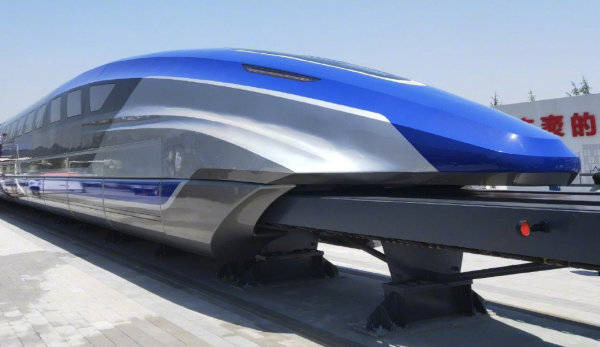
China's new 600 km/hour maglev train
China's rise is essential to understand and technology played an essential role.
In this series of essays I seek to answer two key questions:
Technology's advancement, whether in China or elsewhere, is determined by the number of scientists and engineers at work, their capability (merely adequate vs outstanding vs world-class), the intensity of their focus (motivation / hours per week / belief in the mission), their institutional and governmental support (funding for salaries, supplies, assistants, lab space), academic freedom (ability to explore new ideas,) size and ability to capture addressable markets, freedom from burdensome supervision, regulations, reporting requirements, and other psychological factors (freedom from fear and economic constraints; free exchange of ideas, and being part of a vibrant academic or entrepreneurial community.)
From the isolated labs and celebrated scientific geniuses of the Enlightment in Europe, through the rapid industrialization during the 19th century westward American expansion (steel manufacture, railroads, telephony), through the 20th century rollout of cars and trucks, oil drilling, electrification of lighting and machines, chemical and pharmaceutical production, aircraft, radio, tv, radar, lasers, computers, internet, cell phones the above factors have been at work. The number, size, and quality of engineering teams worldwide have been paramount.
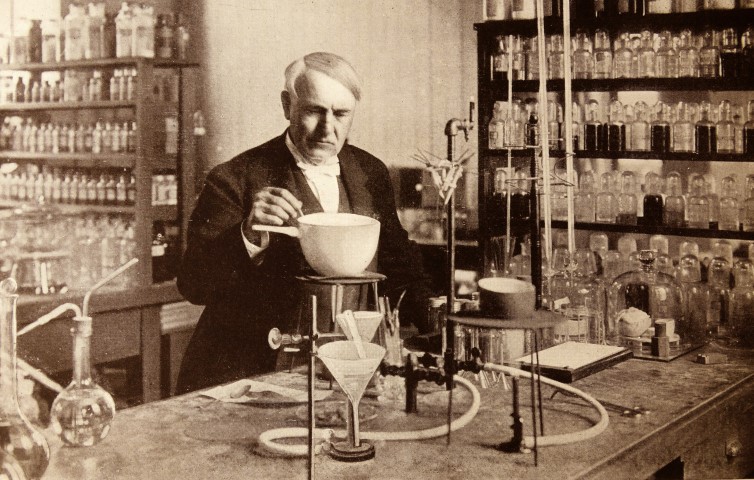
Edison at work in his lab
In this world of science and engineering, competition is a good thing. Occasionally even the threat or actuality of war is motivating (unless you get blown up) with its vastly accelerated governmental and industrial support (exhibit A is the Manhattan Project in 1944/45 that produced the atom bomb; exhibit B might be NASA's putting a man on the moon in 1969 (in response to a perceived Soviet threat.))
In the ancient world China was a tech leader. The Chinese discovered gunpowder in the year 850, and it was put to use by the reigning Sung dynasty against the Mongols. Even earlier in the years 25 to 220 papermaking was documented during the Han period (and later, the printing press.)
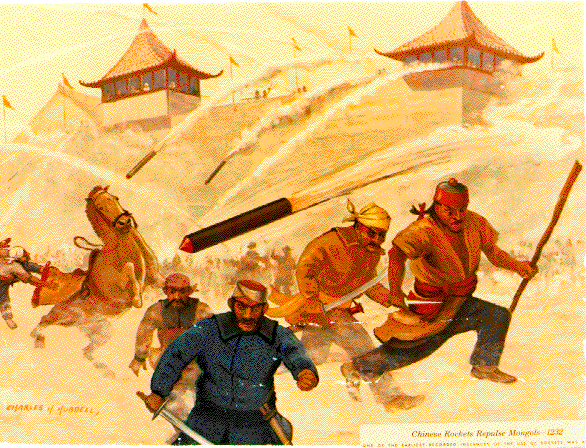
Chinese tech capability has waxed and waned over the millennia. It was massively stunted in the past two centuries by the corruption and monarchical theft of the Qing dynasty and the resulting civil wars and revolution of the Taiping rebellion in the 19th century, the civil war between the communists and the nationalists in the 20th century, the brutal repression, and insane central planning of Mao Tse Tung's "Great Leap Forward" and "Cultural Revolution", not to mention the brutality, suffering , and megadeaths inflicted by European colonial powers in the 19th century and by Japan in the 20th. The Chinese have suffered mightily.
The image of 5 foot, 2 inch Paramount Leader Deng Xiaoping in a Stetson cowboy hat at a rodeo in 1979 forever changed the image of China as well as the nature of its economy. Gone, apparently, was the idiotic communist ideology of Mao's Cultural Revolution. Instead, Deng ushered in the era of unbridled Chinese capitalism. China was open for business. With massive infusions of cash not only by foreign direct investment but also through gigantic state-owned enterprises and private, heavily subsidized Chinese corporations, China was off to the races, building manufacturing capacity and infrastructure.

Deng Xiaoping welcoming the West!
Briefly, Chinese GDP went from < 300 billion dollars in 1980 to 14 trillion dollars in 2019. Trade went from < 40 billion dollars in 1980 to 4 trillion dollars in 2015. Chinese GDP was approximately 2% of world GDP in 1980 and rose to 18% by 2015. In the period 2011 through 2013 China poured more cement than had been used by the United States in the entire 20th century.
This collection of photos documents that The Chinese are Leaving Us in the Dust! KJ Vids' 2017 China's Economic Miracle is an excellent video documentary. Also recommended is the 2020 documentary The Economy of Modern Day China by Economics Explained.
The Chinese miracle was obviously made possible by a wholesale adoption of Western capitalism but with "Chinese characteristics." China's development was led by a hierarchical, authoritarian, command economy. State rule meant that large scale infrastructure could be rolled out without factoring in property rights or public protests. Zhang Weiwei, Deng Xiaoping's scholarly translator, argues the superiority of China's meritocratic system of governance here. "One man, one vote is not right for China," and, he argues, it may not even be optimal for America.
In the 1980s the impression in the West was that China was on the road to a modern, liberal economy with increasing personal freedoms, rule of law, and free trade. This pollyanish Modernization Theory came to a crashing halt in June 1989 when Leader Deng ordered tanks and armed military to crush the freedom-seeking protesters in Tiananmen Square. When the guns finished firing, thousands of students lay dead, alongside the cherished dream/ delusion of an open China.
But, despite this, industrial China rolled on through ensuing leaders to the modern era of China's new dynastic leader-for-life Xi Jinping.
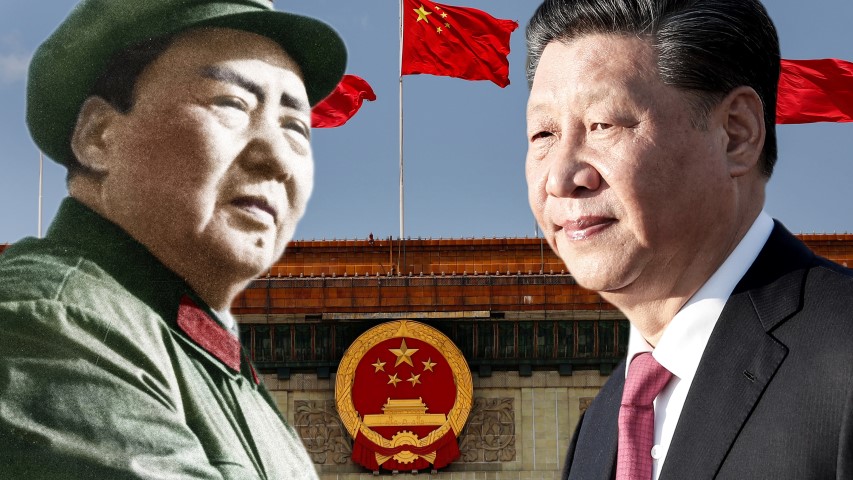
Xi came to power in 2012 for the first of his five year terms as Chairman of the Communist Party. And, under his direction, term limits were abolished in 2018 signaling that Xi would probably extend his reign perhaps to 2035 (when he will be a mere 82 years old.)
Xi appears to be well-qualified for the job with a bachelors in chemical engineering from world-leading Tsinghua University and also a doctorate in law (nb: his dissertation was on Marxist-Leninist theory.) Xi's father was also a major figure during the Cultural Revolution (albeit on the wrong side,) Following this auspicious start Xi had stints successfully governing a series of increasingly large and important provinces.
Bolstered by China's status as the number two economy in the world and by its having the second largest army in the world, Xi has shown no sign of liberalizing the Chinese Communist Party, its grip on Chinese society, nor its relations with the global community.
Unfortunately, in a folie a deux this aggressive, aggrandized, and perhaps paranoid stance was exacerbated by his interaction with America's similarly inclined President Trump. In the long arc of history individual actors (not just nations) matter. Absent Xi and Trump, the world might've been less focused on the threat of a rising China.
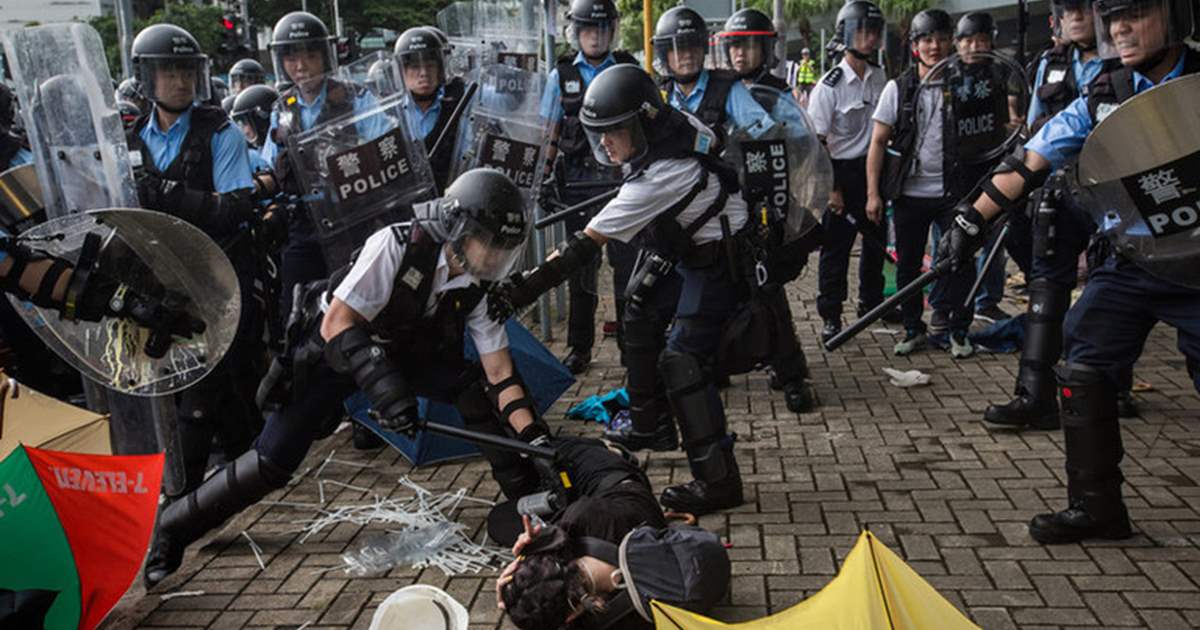
The CCP's thugs dismantling democracy in Hong Kong
The Mandarin-speaking former Prime Minister of Australia, Kevin Rudd, characterizes Xi's goals as a series of concentric circles - like a target - strengthening the Communist Party's hold on the PRC is at the bullseye. Maintaining harmony in the Middle Kingdom is of paramount importance. It even justifies economic and reputational sacrifices. This explains the abhorent and seemingly self-defeating suppression of the Hong Kong freedom protests of 2019 and 2020. This need for authoritarian control also explains the abhorent treatment of Tibetans and Uyghurs and the massive surveillance expenditures.
As a simple approximation China is governed by a strict hierarchy with Chairman Xi Jinping at the top. Immediately below him in the PRC's org chart is the Standing Committee of the Politburo with Xi and its six other members. Their decisions have the force of law, and they are supreme over all other bodies. The members are strictly ranked and are typically drawn from party chiefs of a province (ie, a state like Wuhan) or a big municipality (like Beijing or Shanghai.)
Descending below this level are increasingly large bodies - the Politburo itself, the Central Committe (with 205 members and 171 alternates) and at the bottom the largely symbolic National People's Congress (NPC) consisting of 3000 members that meet for a couple of weeks a year to rubber-stamp proposals and to meet-and-greet other bigwigs and captains of industry for an annual photo-op. There were over 200 billionaires in the NPC class of 2020 (the "Niemann Marxists.") Would Jack Ma (net worth $60 B; founder of Alibaba) or Pony Ma (net worth $47B; founder of Tencent and WeChat) have succeeded without having cozy relationships with their buddies in the NPC? (But note: Jack Ma's recent disappearance — perhaps an opportunity to atone for his wealth and to re-dedicate himself to the glory of the Party.)
China's government is strictly hierarchical like an American corporation but brooks little dissent. There are no political parties. Outspoken journalists face arrest and jail time. NGOs (non-governmental organizations eg human rights watchdogs and even environmental groups ) are suppressed or eliminated. Among the hundreds of officials in the org chart all are Han Chinese (except a rare, token non-Han with perhaps special expertise.)
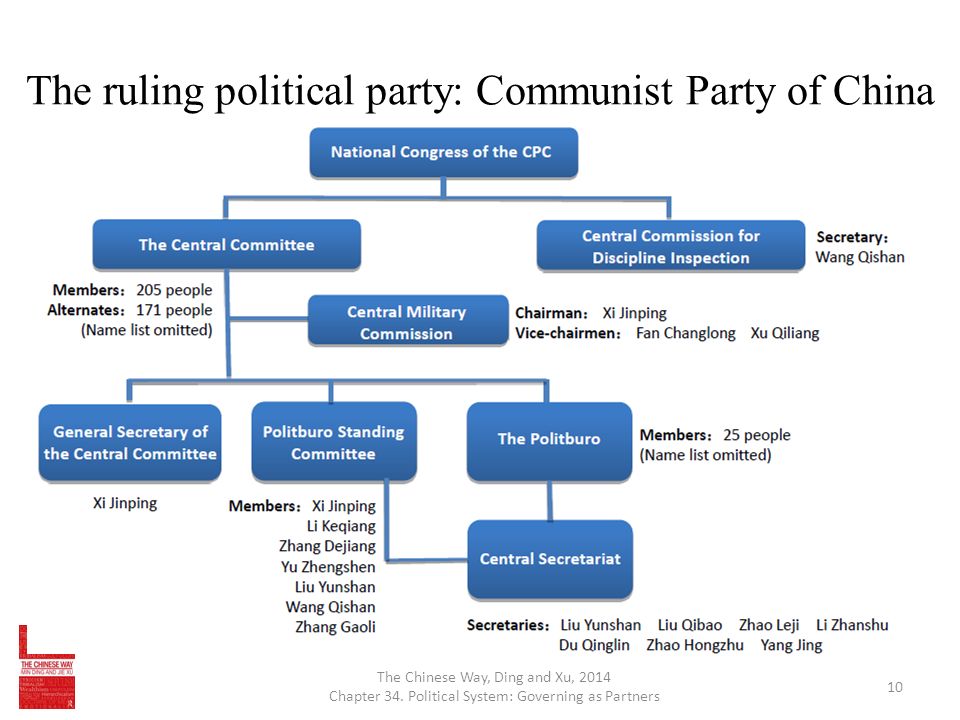
Furthermore, everything is run directly or indirectly by the state. This is most obvious in the titles and roles that Xi Jinping has accumulated. He is not only Chairman of the CCP but also Head of the People's Liberation Army (the PLA,) Head of the Police, etc. Note that the budget for internal security, including China's massive surveillance system, is twice that even of the PLA, all the better to enforce obedience in the Middle Kingdom.
Returning to the miracle of China's economic rise since 1980, the key question is how did they do it? (Dozens of other developing nations — including scores of eager Belt & Road client nations — would love to follow in their footsteps.)
One answer comes from John Ratcliffe, the US's former National Security Advisor under Trump. In a recent opinion piece in the Wall Street Journal (WSJ) he offers the following alliterative mantra: rob, replicate, and replace (the three Rs.). (This simplification serves as my point of departure.) Note: most of Ratcliffe's remarks are behind a WSJ paywall but can be read here.
Interestingly the formula was previously suggested by Royalist Li Xiucheng faced with the Taiping Rebellion (wiki) in the 19th century:
"War with the Western powers is coming and the Qing must buy the best Western cannons and gun carriages, and have the best Chinese craftsmen learn to build exact copies, teaching other craftsmen as well."
But adhering to the formula is not easy. It requires planning and intelligence to know what to rob; hard-working reverse engineers to replicate the tech, and massive government subsidies to manufacture the new tech at a sufficiently massive scale and low enough cost to replace Western products and markets.
Can the PRC's engineers innovate? Can they go beyond merely copying or stealing designs from the West? If your view is that they will never be outstanding innovators, you may soon be proven wrong. Professor George S. Yip of Imperial College London lays out the evidence in his 2018 Talk at Google.
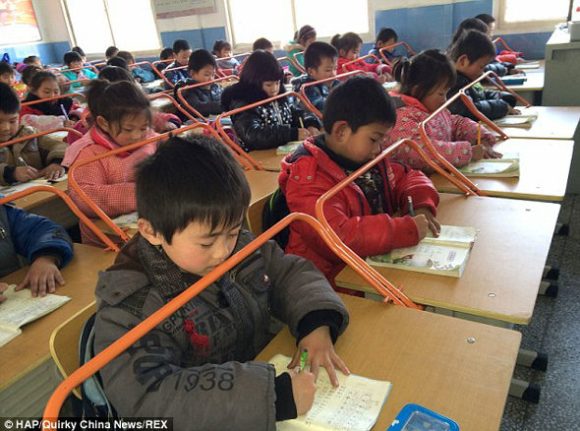
protecting students' eyesight by maintaining distance from their work
The PRC graduates 4.7M scientists and engineers every year as compared with only a half million in America. The PRC has recently nurtured outstanding technical universities of which the crown jewel is Tsinghua (from which Xi Jinping obtained his engineering and law degrees.) With four grandparents and two parents fawning over China's only children, each family spends lavishly on education. The culmination of high school is the rigorous Gaokao exam, which determines placement in the nation's top schools. Do poorly and "burger-flipping" or other menial work may be your lot in life.
But, with all that emphasis on rote memorization and regurgitation in China's education system (not to mention suppression of dissent by the Social Credit System) is there any room left for innovation and creative thinking? YouTube is replete with videos of entrepreneurs in Shenzhen pursuing their dreams. There is plenty of creative ability and zeal.
The extreme work ethic of Chinese R&D workers is not just a cliche. This Wolf Warrior work ethic is exemplified by sleeping rolls under desks. Work until you drop (9AM to 9PM, 6 days a week or more.) When telecom maker Huawei advertises for workers, this is part of their recruiting dogma:
"Huawei people are destined to work harder for a lifetime and suffer more than others"
While the world marvels at Elon Musk's genius, it's obvious to me that it's mainly Elon's willingness to work long hours, sleep under his desk, and suffer. (Thomas Edison got it right: "genius is 10% inspiration, and 90% perspiration.) In my investor days during the 1990s, I would frequently look at Silicon Valley corporate parking lots on weekends - no cars means no zeal - invest elsewhere.)
Will the next Silicon Valley be in China? See this 2019 video from Intelligence Squared — Unresolved: The Techonomic Cold War with China. MIT Professor Yasheng Huang says "Yes!" He even claims to know the city: "Shenzhen," which is the home of telecom giant Huawei (China's Cisco + Apple combined) as well as phone maker ZTE , Tencent (China's Facebook + PayPal) and top drone maker DJI. It's the electronics manufacturing and design center of the PRC.
Time in Shenzhen moves fast; the innovation cycle is rapid; new hardware is rolled out and tested in a matter of weeks. They fail fast and learn from their mistakes.
According to Deng Xiaoping's dictum — cross the river by feeling the stones (that is, by trial an error) — make bold experiments and course-correct in real-time. Contrast that with the fat and happy business culture in the US (or even worse — the glacial conservatism of the EU.)
Since China in 2021 is flush with cash, it can afford outsize R&D budgets for new tech, especially if that tech can also be used for the military. (The Party's policy of civil-military fusion means that tech breakthroughs must also be incorporated into the military.) The PRCs infrastructure (roads, trains, bridges, and power-plants) is world-beating. What's your preference -— solar or wind power plants — they've got them. How about coal-burning or nuclear? How about all of the above on a massive scale?
Tech for healthcare is also emphasized. Prof. George Yip relates the story of General Electric's $150,000 ultrasound machines used in American hospitals. The Chinese adapted and simplifed the design to reduce the cost to $20,000 apiece for their hospitals. (And, from there, back it goes to the US to sell to doctors' offices.)
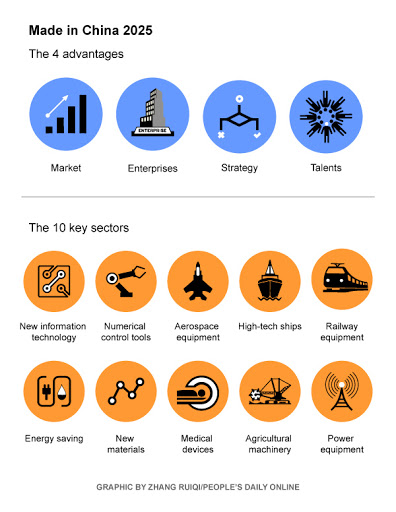
Made in China 2025 (MIC 2025) was a major part of the Five Year Plan set forth in 2015. It emphasized areas of priority for tech advancement and innovation, and hence, areas in which the state would massively subsidize both state-owned enterprises (SOEs) and private corporations. As this US Congressional Report emphasizes, China would advance these developments by direct investment, joint ventures with foreign corporation involving forced tech transfer, direct foreign acquisitions, and recruitment of foreign talent.
In the sections that follow I will illustrate these patterns of tech development through specific examples.
Well known by now is the Trump administration's aggressive actions to counter (among other things) the MIC 2025 program ( which it viewed as violating the terms under which China was admitted to the WTO in 2001.
I've broken out each of these specific examples of Chinese corporate development (and alleged misdeeds) in separate essays below.

From the standpoint of the Party, China's new Social Credit System seems like the perfect way to maintain harmony in the Middle Kingdom. Every purchase, every phone call, every email is grist for the Big AI that computes your social credit score. Praise the Party and your score goes up; complain and your score goes down — every dictator's dream.
A crucial part of this new surveillance state is a network of 200 million (soon to be 600 million) video cameras. Those video feeds are continuously monitored by a massive AI system called — I'm not making this up — Skynet ! China spends twice as much on domestic surveillance as it does on its massive army. Billions of those funds flow into China's facial recognition companies like SenseTime and Megvii.

China's meteoric rise as a global economic superpower may (or may not) continue. Here, I draw a comparison to the Japanese miracle of the 1980s which abruptly ended in the 1990s and never resumed.
There are several potential risks and challenges to China's continued expansion — out-of-control debt, non-productive infrastructure spending (most notably Belt & Road,) competitor nations that can undercut manufacturing, necessary spending on poverty alleviation, alienation of trading partners due to human rights violations and Xi Jinping's aggressive militarization, and environmental destruction.
I welcome substantive comments on all my articles. With your permission I may include excerpts. You can post here anonymously, but to do so you should have a verifiable identity, eg a website, Linked-in ID, or Facebook page, etc. Mail comments to bob AT bobblum DOT com (with the usual syntax.)
7 April 2024: China's Real Estate Collapse Has Only Just Begun: this is a spectaculary good analysis and summary of China's economy by macro-economist Brian McCarthy. Basically, absolutely everything in the PRC is paid for directly or indirectly via China's central bank, which (similar to the US but on a far grander scale) just keeps printing money to pay for everything: real estate, infrastructure, Belt and Road, and tech development. I love his quote: "a rolling loan gathers no loss." (until it doesn't.) China is one giant Ponzi scheme. They've got 100 million paid for but unfinished apartment units, for example.
There may be one upside to Xi Jinping's printing trillions of yuan to support the manufacturing of millions of electric vehicles. The atmosphere (and global warming) doesn't care whether the cars are made by Geely and BYD or by Ford and GM (or by Tesla). There just needs to be fewer gas guzzlers.